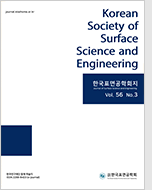
- Past Issues
- e-Submission
-

2021 Impact Factor 1.766
5-Year Impact Factor 1.674
Editorial Office
- +82-2-563-0935
- +82-2-558-2230
- submission@kssse.or.kr
- https://www.kssse.or.kr/

2021 Impact Factor 1.766
5-Year Impact Factor 1.674
The Korean Society of Surface Science and Engineering 2024;57(5):406-415. Published online: Nov, 5, 2024
DOI : https://doi.org/10.5695/JSSE.2024.57.5.406
Using DC magnetron sputtering, we deposited a bilayer composed of a seed layer consisting of Ti, Cr, Co, and Zr, and an overlayer of Ag on MgO(001) single crystal substrates, creating self-assembled nanostructures. When Ti was used as the seed layer, it was observed that the formed nano-dots inherently aggregated into dot shapes. Additionally, Cr, Co, and Zr were chosen to investigate their influence on SLAA(Seed layer Assisted Agglomeration) depending on the seed layer material, revealing different shapes of the formed nano-dots. Moreover, it was observed that aggregation was inhibited as the thickness of the seed layer exceeded a critical point. X-ray diffraction analysis of the Ti seed layer revealed epitaxial growth of Ag along the (001) direction of the MgO substrate. In contrast, no epitaxial growth was observed when Cr, Co, and Zr were used as seed layer materials. Ultimately, Ti was identified as the most suitable seed layer material for the fabrication of self-assembled nanostructures utilizing the aggregation phenomenon of the bilayer. This research is deemed sufficiently valuable in addressing the limitations associated with the low productivity and high cost of current nano thin film processes.
Keywords Seed Layer; Nanostructure; Agglomeration phenomenon; Self-Organized fabrication process; Epitaxial growth.